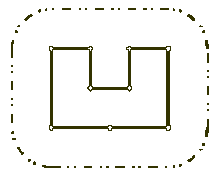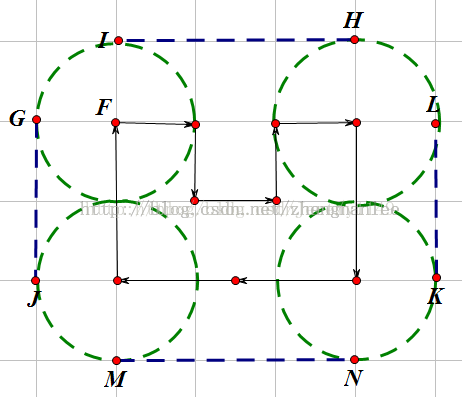81-POJ-Wall(计算几何)
| Time Limit: 1000MS | Memory Limit: 10000K | |
| Total Submissions: 41143 | Accepted: 14068 |
Description

Your task is to help poor Architect to save his head, by writing a program that will find the minimum possible length of the wall that he could build around the castle to satisfy King's requirements.
The task is somewhat simplified by the fact, that the King's castle has a polygonal shape and is situated on a flat ground. The Architect has already established a Cartesian coordinate system and has precisely measured the coordinates of all castle's vertices in feet.
Input
Next N lines describe coordinates of castle's vertices in a clockwise order. Each line contains two integer numbers Xi and Yi separated by a space (-10000 <= Xi, Yi <= 10000) that represent the coordinates of ith vertex. All vertices are different and the sides of the castle do not intersect anywhere except for vertices.
Output
Sample Input
9 100
200 400
300 400
300 300
400 300
400 400
500 400
500 200
350 200
200 200
Sample Output
1628
Hint
Source

证明:

先从简单的例子看起:假设现在的凸包有四个顶点构成,可以就一个顶点来观察,我们可以看到此处的周角由四个部分组成:2个直角,一个凸包内角,一个圆弧对应的圆心角。
同理每个顶点都有类似的关系,同时周角固定为360度,而凸包内角和为(4-2)*180 ;
所以总的圆弧对应的圆心角 = 4个周角 - 4 * 2个直角 - 4个凸包内角 = 4 * 360 - 4 * 2 * 90 - (4-2)*180 = 1440-720-360 =360度。
现在推广到n个顶点的凸包:
则所有内角和 = 周角 * n - n * 2个直角 - (n-2)*180 = 360*n - n *180 - n*180 + 360 = 360度。
故对于任意的凸包,所有的圆弧对应的圆心角之和都为360度,它们构成一个完整的圆。
ac代码如下:
#include <iostream>
#include <algorithm>
#include <cstring>
#include <cmath>
using namespace std;
#define N 10005
const double PI = acos(-1.0); int n,tot;//n为二维平面上点的个数,tot为凸包上点的个数
struct node {
int x,y;
}a[N],p[N]; //p[]用来储存凸包 double dis(node a1,node b1){ //两点间距离公式
return sqrt((a1.x-b1.x)*(a1.x-b1.x)+(a1.y-b1.y)*(a1.y-b1.y) + 0.00);
} //叉积:返回结果为正说明p2在向量p0p1的左边(三点构成逆时针方向);
//为负则相反;为0则三点共线(叉积的性质很重要)
double multi(node p0,node p1,node p2){ //
return (p1.x-p0.x)*(p2.y-p0.y)-(p2.x-p0.x)*(p1.y-p0.y);
} //极角排序:极角排序是根据坐标系内每一个点与x轴所成的角,逆时针比较。按照角度从小到大的方式排序
int cmp(node p1,node p2){ //极角排序;
int x=multi(p1,p2,a[0]);
if(x>0||(x==0&&dis(p1,a[0])<dis(p2,a[0])))
return 1;
return 0;
} void Graham(){ //求凸包
int k=0;
for(int i=0;i<n;i++) //找到最下最左的一个点
if(a[i].y<a[k].y||(a[i].y==a[k].y&&a[i].x<a[k].x))
k=i;
swap(a[0],a[k]); //将其设置为第一个点
sort(a+1,a+n,cmp);
tot=2,p[0]=a[0],p[1]=a[1]; //p[]模拟栈,用来储存凸包
for(int i=2;i<n;i++){
while(tot>1&&multi(p[tot-1],p[tot-2],a[i])>=0)
tot--; //右拐就回退
p[tot++]=a[i]; //左拐就放入
}
} double getArea(){
struct node b[3];
b[0] = p[0], b[1] = p[1], b[2] = p[2];
double area = 0;
for(int i = 2; i < tot; i++){
area += multi(b[0], b[1], p[i]) / 2.0;
b[1] = p[i];
}
return area;
} double getGirth(){
double rt = 0;
for(int i = 0; i < tot; i++){
rt += dis(p[i], p[(i+1)%tot]);
}
return rt;
} int main(){
double L;
while(cin >> n >> L){
tot = 0;
for(int i = 0; i < n; i++){
cin >> a[i].x >> a[i].y;
}
Graham();
double res = getGirth();
res += 2*PI*L;
cout << int(res + 0.5) << endl;
}
return 0;
}
81-POJ-Wall(计算几何)的更多相关文章
- POJ 1113 Wall(计算几何の凸包)
Description Once upon a time there was a greedy King who ordered his chief Architect to build a wall ...
- POJ 1556 计算几何+最短路
代码1: #include<iostream> #include<stdio.h> #include<string> #include<string.h> ...
- POJ 2954-Triangle(计算几何+皮克定理)
职务地址:POJ 2954 意甲冠军:三个顶点的三角形,给出,内部需求格点数. 思考:就像POJ 1265. #include <stdio.h> #include <math.h& ...
- poj 1410 计算几何
/** 注意: 千万得小心..就因为一个分号,调了一个晚上... **/ #include <iostream> #include <algorithm> using name ...
- poj 2653 计算几何
#include <iostream> #include <cstring> #include <algorithm> #include <cmath> ...
- poj 1269 计算几何
/** 判断直线位置关系 **/ #include <iostream> #include <cmath> #include <cstdio> using name ...
- poj 3304 计算几何
大意: 是否存在一条直线,使所有线段在直线上的投影至少交与一点 思路: 转换为是否存在一条直线与所有的线段相交,做这条直线的垂线,那么垂线即为所求 **/ #include <iostream& ...
- poj 2398 计算几何
#include <iostream> #include<cstdio> #include<cstring> #include <algorithm> ...
- BZOJ 1113 Wall ——计算几何
凸包第一题. 自己认为自己写的是Andrew 其实就是xjb写出来居然过掉了测试. 刚开始把pi定义成了int,调了半天 #include <map> #include <cmath ...
- POJ 3855 计算几何·多边形重心
思路: 多边形面积->任选一个点,把多边形拆成三角,叉积一下 三角形重心->(x1+x2+x3)/3,(y1+y2+y3)/3 多边形重心公式题目中有,套一下就好了 计算多边形重心方法: ...
随机推荐
- 应用程序 system 函数
1.使用实例 system("ps"); //执行shell命令ps 2.使用注意事项 system相当于创建了一个子进程,在子进程中调用程序.所以system执行的程序会继承主进 ...
- MapReduce项目中的一个JVM错误问题分析和解决
最近一周都在查项目的各种问题,由于对原有的一个MapReduce分析数据的项目进行重构,减少了运行时的使用资源,但是重构完成后,在Reduce端总是不定时地抛出JVM的相关错误,非常随机,没有发现有什 ...
- Easyui combotree 获取自定义ID属性方法
1.设置属性 <input id="cc" class="easyui-combotree" data-options="url:'tree_d ...
- tomcat:A docBase * inside the host appBase has been specifi, and will be ignored
警告: A docBase D:\apache-tomcat-8.5.12\webapps\webapps\projectname inside the host appBase has been ...
- 未注册在本地的Windows 2008 / Windows 7 X64的:'Microsoft.Jet.OLEDB.4.0'提供
在服务器上部署项目的时候遇到如下错误:'Microsoft.Jet.OLEDB.4.0'提供在本地没有注册 服务器是WIN2008 导致这个错误主要有几个原因: 1,服务器上没有装MS Excel中的 ...
- DataFactory+MySQL数据构造
前言:DataFactory是一种快速生产测试数据的可视化工具,是一种强大的数据生成器,该工具支持DB2.Oracle.Sybase.SQL Server数据库,支持ODBC连接方式,且通过ODBC连 ...
- 第五章 服务容错保护: Spring Cloud Hystrix
在微服务架构中, 存在着那么多的服务单元, 若一个单元出现故障, 就很容易因依赖关系而引发故障的蔓延,最终导致整个系统的瘫痪,这样的架构相较传统架构更加不稳定.为了解决这样的问题, 产生了断路器等一系 ...
- Zookeeper的几个应用场景
场景一 有这样一个场景:系统中有大约100w的用户,每个用户平 均有3个邮箱账号,每隔5分钟,每个邮箱账需要收取100封邮件,最多3亿份邮件需要下载到服务器中(不含附件和正文).用20台机器划分计算的 ...
- Linux下安装php的memcached扩展(memcache的客户端)
php的扩展memcache,不支持cas,所以我们要装memcached扩展,memcached扩展是基于libmemcached,所以要先安装libmemcached 一.下载软件 1.libme ...
- application-defined exception
dataSnap服务器,客户端调用的时候写错了一句话, SQLConnection1->CloneConnection(); 改为 SQLConnection1->Close(); 就好了 ...
